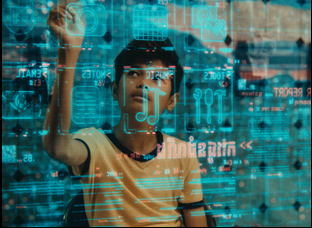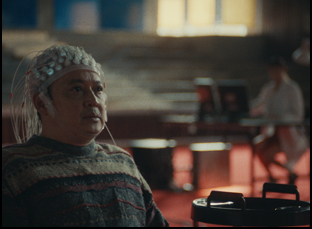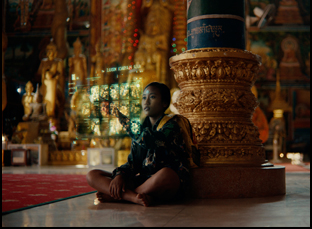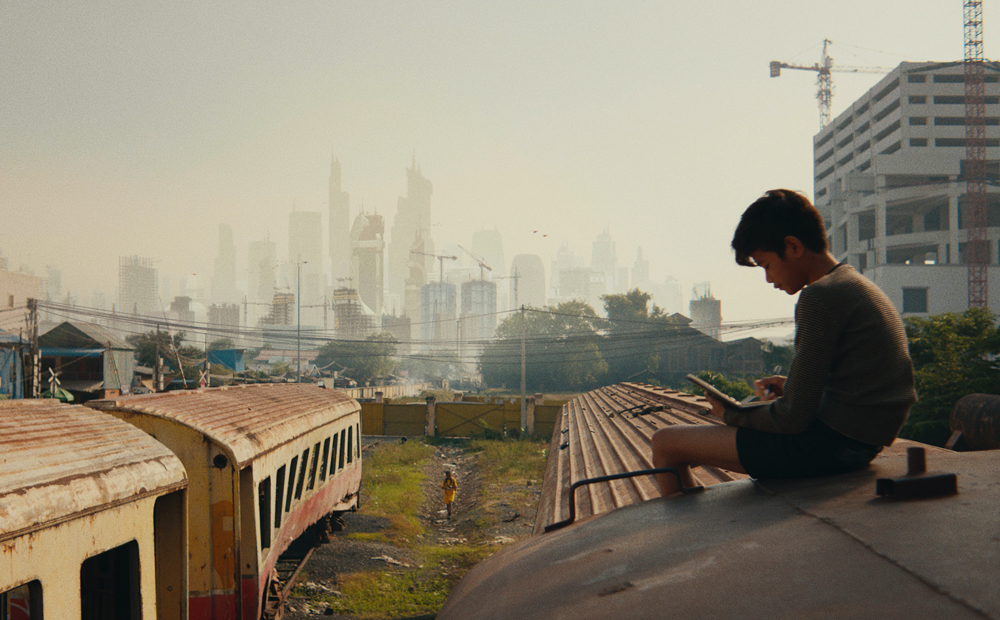On the first day of filming “Karmalink” in the heart of Cambodia, Jake Wachtel and his crew were setting up to film a scene for the sci-fi adventure when a crowd began to gather around the set. Surely, the sight of an old woman wearing a futuristic headset would draw attention and although the scene itself was a relatively quiet one, in which the elder was having her memory downloaded back into her consciousness, the production could feed off the excitement of the onlookers, knowing that it was a relatively rare opportunity to present their lives on the big screen.
“Being there in the village and feeling everyone around me and that energy, that was a big buzz and it was also like how can we capture this, how can we stuff the frames?” said Wachtel, an American who sought a life working for nonprofits in Cambodia and realizing he had something unique to offer with his filmmaking background. “The sense of community is so important that I want people to feel this vibe that there are people everywhere all the time hanging out, so that was something in the moment that we were really working to lean into.”
That energy is felt throughout Wachtel’s narrative debut feature, which sees the future in Southeast Asia just as the director did when he taught a workshop in Phnom Penh for Filmmakers Without Borders in 2014. As he saw the city’s skyline grow rapidly with construction crews clearing out villages that had been there for generations for shiny new buildings, there were more encouraging signs of progress in his midst as the young students he taught were both tech-savvy and steeped in the cultural totems that had come before them, a marriage that manifests itself into “Karmalink” where the Buddhist belief in reincarnation is behind the invention of the Connectove, an innovation of Dr. Vattanak Sovann (Sahajak Boonthanakit), whose device can offer users a greater consciousness than they’ve ever experienced before by piecing together parts of their mind so effectively as to trigger memories of their past lives.
For an older generation, this brings comfort, but for the young Leng Heng (Leng Heng Prak, who tragically passed away shortly after production), whose past lives come back vividly in his dreams without the help of the device, there is quite literally a potential goldmine in his one of his previous timelines and along with Srey Leak (Srey Leak Chhith), a new friend from the neighborhood, he attempts to trace back steps he had not physically taken himself to attempt to lift his community out of their impoverished conditions before developers overtake it. By the end of “Karmalink,” it isn’t only the kids who are able to see their surroundings in a new light when the film lovingly looks upon the remnants of past civilization as building blocks for the future rather than detritus blocking the path forward, and Wachtel takes inspiration from his protagonists when it’s clear he’s about as beholden to any notions of how things have been done before and driven by a sense of discovery, yielding an unusually sophisticated young adult-led thriller.
With the film arriving in the U.S. this week after premiering last fall in the Critics Week section of the Venice Film Festival, Wachtel spoke about how a variety of interests and detours led to making “Karmalink,” making sure the spirit of Cambodia made its way onto the screen and honoring history and the promise of what’s to come throughout.

Over the course of the year, you really get to know a place and I really fell in love with the community where my students were living. It was such a beautiful and life-changing experience and I was bearing witness to a lot of ways the community was changing. When I first moved to Cambodia, there were two skyscrapers on the horizon and now there’s dozens in the process of being built, so there’s a lot of change happening and it was only at the end of my year of teaching that the first seed of the idea came into my mind [where] I could talk about development and displacement. And I’ve long been a huge sci-fi nerd. When I was a little kid, I was obsessed with Ray Bradbury short stories. I would just cycle through them night after night and [when] this idea popped into my head, [I wondered] can we tell a story about these things that interest me on a sociopolitical level, set in this community that I love, celebrating what I love about it and what it’s given me, which is this deep sense of family and community.
I loved the idea of reincarnation being thought of in technological terms. How did those things fuse together?
I studied neuroscience in college and I’m an avid meditator – one of the reasons I moved to Cambodia was that I wanted to be immersed in a place that is Buddhist and I’ve been a student of Buddhism for over a decade. I started to see these different threads in my life come together in a single story that got me really excited and I love sci-fi that has scientist characters. I think there’s an alternate life path where I became a scientist that would’ve been very fun and viable and I love sci-fi in that way that can kind of explore fundamental questions around science and the scientific method.
At the same time, it all comes back to this fascination with the brain and this meditation practice, so that was a foundational aspect of the film and if you go back and read the first draft, it had way more of the science in it, and we pulled that back and shaped it a little bit more because I was more interested in a more ethereal mix of the scientist character who is deeply spiritual on a quest for enlightenment, but through digital means. Growing up in Silicon Valley, I saw a lot of techno-utopianists firm in their belief that they are unlocking enlightenment for society and now that I feel our view of those guys who were heroes in the early days of Silicon Valley is more complex as now we see more the societal ramifications.
Christopher Larsen’s my co-writer and I came to him with a script I’d been working on for some time and he picked it apart and rebuilt if from the ground up. He’s a genius, and [also] an American, but living in Lao for many years and he has a deep understanding of the Buddhist culture in this part of the world and also the sociopolitical questions that we’re unpacking in the film. He could move the story forward in beautiful new directions, and in the first iteration of the script, the character of Vattanak, the scientist, was trying to live forever, but we’ve seen that a lot before in sci-fi. It was conversations with Chris that we realized we wanted to do a different take on what his science project was and Chris had this idea of instead of having visions of one past life, let’s look at many past lives over time. All of a sudden, we start to open up all these doors talking about memory and the importance of memory, so I can’t say enough about how highly indebted I am to Chris for giving shape to this story.

Yeah, people have asked me is this a kids’ film because it’s got two kid protagonists and they’re not adults, but there’s a lot of media that panders to kids or thinks they don’t understand the world. I love media that treats them seriously. I was actually a preschool teacher and studied developmental psychology. I’ve been a birthday party magician, a camp counselor and I’ve spent a lot of time with kids, trying to see the world from their perspective and this story is these kids growing into an understanding of how the world works, growing out of some naiveté to understand what is in their control and how much is actually not in their control [with] these forces of progress. And that’s the same thing that I feel, right? We’re on this runaway train and we can’t control it [where] I feel like I have to have my phone in order to do my job, to communicate with friends and it’s like I don’t have a choice. It’s not entirely consensual what’s happening with technology in our lives.This story, in some ways, about the kids is an allegory of this process.
One of the striking elements of this is how you’re able to look at some of this ancient architecture in Cambodia through a futuristic lens simply from the angle you shoot from. What was it like to frame this world visually?
This was in early conversations with my director of photography Rob Leitzell, we knew we had many different worlds we were capturing. We had the dreams of the past life, we have what’s going on now. We have this timeline with the scientists, we have the augmented reality space, and we have playback of the dreams, so we spent a lot of time figuring out what’s the visual language that’s going to hold these spaces as their own, but feel like they’re part of the same movie. A lead we took in every department, whether it was with camera or production design, music or sound was from the Cambodian landscape, which is this crazy amalgamation of the past and the future coexisting – recycled materials, nature and technology. My production designer Olga [Myasnikova] called it “power-clashing” [where] we have all of these things that are really strong in what they represent, but they’re all together in the frame there, so we took inspiration from what it feels like to be in Cambodia.

Yeah, my two lead actors were my students and I wrote with the two of them in mind, their personalities, and that was a central piece of this whole project. Having that preexisting relationship with them for years kept me really grounded during the shoot. We had a long rehearsal process of a couple of months that was a fun exploration of going through the script several times and getting really familiar with it and our crew is [around] 80% Cambodian. We had a couple people come in from America, France, and the Philippines, but for the most part, it was a local crew and that was immensely gratifying and also really integral to the process for me as an outsider to tell this story in Cambodia. I had to lean hugely on this Cambodian crew to get it right, and what I’m most excited for in this whole process is to share it with the Cambodian public. It’s going to be really fun.
You’ve been around the world a little bit already with the film. What’s it been like to get this out there?
We got to premiere at the Venice Film Festival, which was such a trip [because] we haven’t screened it in Cambodia publicly yet, but Cambodia’s been my home base for many years now and to go from Cambodia to Venice was a big change, and it’s so cool to see people respond to it, particularly the fact that it’s a Cambodian story set in Cambodian culture. I really fell in love with Cambodia and I felt I was given such a great gift in my time there, so to get to share that with the world now here with our release coming up, I’m so excited to get to share a little slice of this place that I love with so many people. It’s something I really love about the magic of cinema is the ability to collapse distance and bring us into contact with people who might otherwise seem very far away from us and we can create these relationships. That’s the thing I’m most excited about as it goes wide now and we share it with more people — to bring people into contact with Cambodia, this place that I love.
“Karmalink” opens on July 15th in Los Angeles at the Lumiere Music Hall, the Bay Area at the Rialto Lakeside Elmwood and the Rialto Lakeside Sonoma and in Seattle at the SIFF Film Center. It will also be available on Apple TV, Amazon, Google Play, Vudu, and XFinity Cable.




